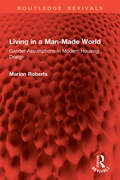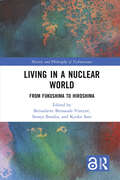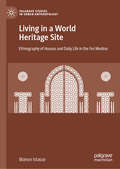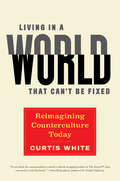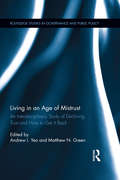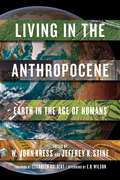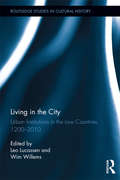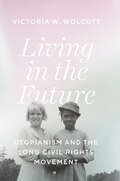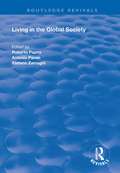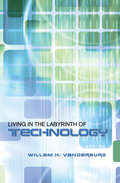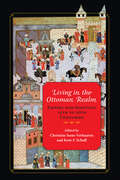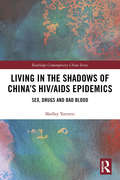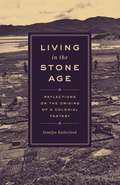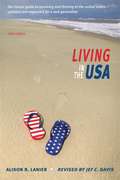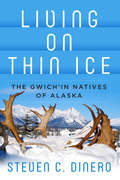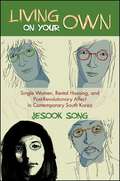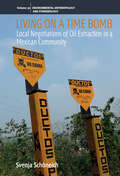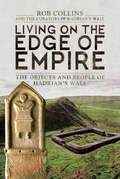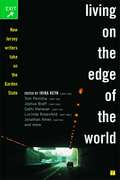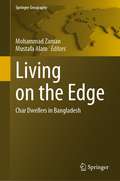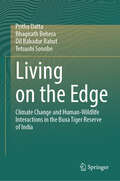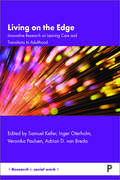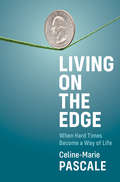- Table View
- List View
Living in a Man-Made World: Gender Assumptions in Modern Housing Design (Routledge Revivals)
by Marion RobertsThere are powerful assumptions about gender divisions inscribed in the built environment. Housing is the site of some complex processes in society. In making and remaking their homes, women and men define their place in the world and are defined by it. Taking a historical perspective, Living in a Man-Made World (originally published in 1991) is the first to make a complete examination of the relationship of gender to housing design. Design is seen in broad terms and revealed as part of the social process of society, rather than a separate sphere in which the architect has sole responsibility for decision making. Many of the ills of the contemporary environment can be traced to the barriers that have been built up between the concerns of social policy, planning and architecture. By breaking down these barriers through a synoptic study of how gender assumptions have operated in the design of housing, this book points the way to how improvements in design and in the built environment may be better achieved.
Living in a Nuclear World: From Fukushima to Hiroshima (History and Philosophy of Technoscience)
by Bernadette Bensaude-VincentThe Fukushima disaster invites us to look back and probe how nuclear technology has shaped the world we live in, and how we have come to live with it. Since the first nuclear detonation (Trinity test) and the bombings of Hiroshima and Nagasaki, all in 1945, nuclear technology has profoundly affected world history and geopolitics, as well as our daily life and natural world. It has always been an instrument for national security, a marker of national sovereignty, a site of technological innovation and a promise of energy abundance. It has also introduced permanent pollution and the age of the Anthropocene. This volume presents a new perspective on nuclear history and politics by focusing on four interconnected themes–violence and survival; control and containment; normalizing through denial and presumptions; memories and futures–and exploring their relationships and consequences. It proposes an original reflection on nuclear technology from a long-term, comparative and transnational perspective. It brings together contributions from researchers from different disciplines (anthropology, history, STS) and countries (US, France, Japan) on a variety of local, national and transnational subjects. Finally, this book offers an important and valuable insight into other global and Anthropocene challenges such as climate change.
Living in a World Heritage Site: Ethnography of Houses and Daily Life in the Fez Medina (Palgrave Studies in Urban Anthropology)
by Manon IstasseThrough a thick ethnography of the Fez medina in Morocco, a World Heritage site since 1981, Manon Istasse interrogates how human beings come to define houses as heritage. Istasse interrogates how heritage appears (or not) when inhabitants undertake construction and restoration projects in their homes, furnish and decorate their spaces, talk about their affective and sensual relations with houses, face conflicts in and about their houses, and more. Shedding light on the continuum between houses-as-dwellings and houses-as-heritage, the author establishes heritage as a trajectory: heritage as a quality results from a ‘surplus of attention’ and relates to nostalgia or to a feeling of threat, loss, and disappearance; to values related to purity, materiality, and time; and to actions of preservation and transmission. Living in a World Heritage site provides a grammar of heritage that will allow scholars to question key notions of temporality and nostalgia, the idea of culture, the importance of experts, and moral principles in relation to heritage sites around the globe.
Living in a World that Can't Be Fixed: Reimagining Counterculture Today
by Curtis White&“This is a book about counterculture, and that&’s a problem . . . &“ So begins Curtis White&’s thrilling call for the revitalization of counterculture today. The problem, White argues, is twofold: first, most of us think of counterculture as a phenomenon stuck in the 1960s, and, second, what passes as counterculture today . . . simply isn&’t. Nevertheless, a reimagined counterculture is our best hope to save the planet, bypass social antagonisms, and create the world we actually want to live in. Now. White—&“the most inspiringly wicked social critic of the moment" (Will Blythe, Elle)—shows how the products of our so-called resistance, from Ken Burns to Black Panther, rarely offer a meaningful challenge to power, and how our loyalty to the &“American Lifestyle&” is self-defeating and keeps us from making any real social change. The result is an inspiring case for practicing civil disobedience as a way of life, and a clear vision for a better world—full of play, caring, and human connection.
Living in an Age of Mistrust: An Interdisciplinary Study of Declining Trust and How to Get it Back (Routledge Studies in Governance and Public Policy)
by Matthew N. Green Andrew I. YeoTrust is a concept familiar to most. Whether we are cognizant of it or not, we experience it on a daily basis. Yet trust is quickly eroding in civic and political life. Americans’ trust in their government has reached all-time lows. The political and social consequences of this decline in trust are profound. What are the foundations of trust? What explains its apparent decline in society? Is there a way forward for rebuilding trust in our leaders and institutions? How should we study the role of trust across a diverse range of policy issues and problems? Given its complexity, trust as an object of study cannot be claimed by any single discipline. Rather than vouch for an overarching theory of trust, Living in an Age of Mistrust synthesizes existing perspectives across multiple disciplines to offer a truly comprehensive examination of this concept and a topic of research. Using an analytical framework that encompasses rational and cultural (or sociological) dimensions of trust, the contributions found therein provide a wide range of policy issues both domestic and international to explore the apparent decline in trust, its impact on social and political life, and efforts to rebuild trust.
Living in the Anthropocene: Earth in the Age of Humans
by Edward O. Wilson Elizabeth Kolbert Thomas E. Lovejoy John W. Kress Jeffrey K. StineExplores the causes and implications of the Anthropocene, or Age of Humans, from multiple points of view including anthropological, scientific, social, artistic, and economic.Although we arrived only recently in Earth's timeline, humans are driving major changes to the planet's ecosystems. Even now, the basic requirements for human life--air, water, shelter, food, nature, and culture--are rapidly transforming the planet as billions of people compete for resources. These changes have become so noticeable on a global scale that scientists believe we are living in a new chapter in Earth's story: the Anthropocene, or Age of Humans. Living in the Anthropocene: Earth in the Age of Humans is a vital look at this era. The book contextualizes the Anthropocene by presenting paleontological, historical, and contemporary views of various human effects on Earth. It discusses environmental and biological systems that have been changed and affected; the causes of the Anthropocene, such as agricultural spread, pollution, and urbanization; how societies are responding and adapting to these changes; how these changes have been represented in art, film, television, and literature; and finally, offers a look toward the future of our environment and our own lives.
Living in the City: Urban Institutions in the Low Countries, 1200–2010 (Routledge Studies in Cultural History)
by Leo Lucassen Wim WillemsThe city is a place to find shelter, a market place, and an elevator for social mobility and success. But the city is also a place that frightens people and that can marginalize newcomers. Living in the City tries to understand what pulls people to the city since the High Middle Ages, focusing on one of the earliest urbanized regions in the world, the Low Countries. The book is a quest for new insights that leads the reader from Medieval Ghent and Bruges, through the Dutch Golden Age and the mass urbanization in the age of Industrialization to the present Eurodelta. A region that emerged in the last century with Antwerp, Rotterdam and Amsterdam as nodal points in a global urban network. To understand the motivations of so many to settle in cities this book focuses on a wide variety of urban institutions. What was the role of churches, guilds and businesses, but also theaters, architecture, parks and pavements? What were the cultural, economic, social, political and spatial dynamics that transformed cities into centers of creativity and innovation? How did the attractiveness of cities change over time, when cities lost their autonomy and became part of the nation state and global forces? In this book a team of internationally reknown scholars (in the field of history, art, literature, economy and the social sciences) look for continuity and change in the last eight centuries of urban developments in one of the most remarkable urban regions of the world.
Living in the Future: Utopianism and the Long Civil Rights Movement
by Victoria W. WolcottLiving in the Future reveals the unexplored impact of utopian thought on the major figures of the Civil Rights Movement. Utopian thinking is often dismissed as unrealistic, overly idealized, and flat-out impractical—in short, wholly divorced from the urgent conditions of daily life. This is perhaps especially true when the utopian ideal in question is reforming and repairing the United States’ bitter history of racial injustice. But as Victoria W. Wolcott provocatively argues, utopianism is actually the foundation of a rich and visionary worldview, one that specifically inspired the major figures of the Civil Rights Movement in ways that haven’t yet been fully understood or appreciated. Wolcott makes clear that the idealism and pragmatism of the Civil Rights Movement were grounded in nothing less than an intensely utopian yearning. Key figures of the time, from Martin Luther King Jr. and Pauli Murray to Father Divine and Howard Thurman, all shared a belief in a radical pacificism that was both specifically utopian and deeply engaged in changing the current conditions of the existing world. Living in the Future recasts the various strains of mid-twentieth-century civil rights activism in a utopian light, revealing the power of dreaming in a profound and concrete fashion, one that can be emulated in other times that are desperate for change, like today.
Living in the Future: Utopianism and the Long Civil Rights Movement
by Victoria W. WolcottLiving in the Future reveals the unexplored impact of utopian thought on the major figures of the Civil Rights Movement. Utopian thinking is often dismissed as unrealistic, overly idealized, and flat-out impractical—in short, wholly divorced from the urgent conditions of daily life. This is perhaps especially true when the utopian ideal in question is reforming and repairing the United States’ bitter history of racial injustice. But as Victoria W. Wolcott provocatively argues, utopianism is actually the foundation of a rich and visionary worldview, one that specifically inspired the major figures of the Civil Rights Movement in ways that haven’t yet been fully understood or appreciated. Wolcott makes clear that the idealism and pragmatism of the Civil Rights Movement were grounded in nothing less than an intensely utopian yearning. Key figures of the time, from Martin Luther King Jr. and Pauli Murray to Father Divine and Howard Thurman, all shared a belief in a radical pacificism that was both specifically utopian and deeply engaged in changing the current conditions of the existing world. Living in the Future recasts the various strains of mid-twentieth-century civil rights activism in a utopian light, revealing the power of dreaming in a profound and concrete fashion, one that can be emulated in other times that are desperate for change, like today.
Living in the Global Society (Routledge Revivals)
by Roberto Papini Antonio Pavan Stefano ZamagniFirst published in 1997, Living in the Global Society reflects on the fundamental concept of global economy as the driving force for development, and examines how ethical values can direct this towards the welfare of humankind in a future where peace will reign. The contributions stem from an international conference held in Rome on ‘Economic Growth, for What Kind of Future?’. The book examines four main themes: development and underdevelopment; globalization in the fields of economics, finance, trade, migration and culture; the shape of the world to come through management of resources and goods; and finally the challenge of globalization moving from fragmentation towards social growth based on cooperation and integration. It is suggested that only a civil society that is also developed at an international level can provide the basis for a true global democracy and true peace. This book asks, how far are we along the path towards its creation?
Living in the Labyrinth of Technology
by Willem H. VanderburgFrom the very beginnings of their existence, human beings have distinguished themselves from other animals by not taking immediate experience for granted. Everything was symbolized according to its meaning and value: a fallen branch from a tree became a lever; a tree trunk floating in the river became a canoe. Homo logos created communities based on cultures: humanity's first megaproject.Further symbolization of the human community and its relation to nature led to the possibility of creating societies and civilizations. Everything changed as these interposed themselves between the group and nature. Homo societas created ways of life able to give meaning, direction, and purpose to many groups by means of very different cultures: humanity's second megaproject. What Das Kapital did for the nineteenth century and La technique did for the twentieth, Willem H. Vanderburg's Living in the Labyrinth of Technology seeks to create for the twenty-first century: an attempt at understanding the world in a manner not shackled to overspecialized scientific knowing and technical doing. Western civilization may well be creating humanity's third megaproject, based not on symbolization for making sense of and living in the world, but on highly specialized desymbolized knowing stripped of all peripheral understanding.Vanderburg focuses on two interdependent forces in his narrative, namely, people changing technology and technology changing people. The latter aspect, although rarely considered, turns out to be the more critical one for understanding the spectacular successes and failures of contemporary ways of life. As technology continues to change the social and physical world, the experiences of this world 'grow' people's minds and society's cultures, thereby re-creating human life in the image of technology. Living in the Labyrinth of Technology argues that the twenty-first century will be dominated by this pattern unless society intervenes on human (as opposed to technical) terms.
Living in the Ottoman Realm: Empire and Identity, 13th to 20th Centuries
by Kent F. Schull Christine Isom-VerhaarenLiving in the Ottoman Realm brings the Ottoman Empire to life in all of its ethnic, religious, linguistic, and geographic diversity. The contributors explore the development and transformation of identity over the long span of the empire's existence. They offer engaging accounts of individuals, groups, and communities by drawing on a rich array of primary sources, some available in English translation for the first time. These materials are examined with new methodological approaches to gain a deeper understanding of what it meant to be Ottoman. Designed for use as a course text, each chapter includes study questions and suggestions for further reading.
Living in the Shadows of China's HIV/AIDS Epidemics: Sex, Drugs and Bad Blood (Routledge Contemporary China Series)
by Shelley TorcettiIdentifying the existing challenges and shortfalls of China's current HIV/AIDS programming, this book provides an understanding of the history of HIV/AIDS in China, comparing government responses to global best practice in prevention and treatment. Considering three key populations in China, namely, female sex workers, people who inject drugs and floating migrants, Living in the Shadows of China's HIV/AIDS Epidemics highlights the effects of high mobility and marginalisation on the spread of HIV in China. It is argued that these groups often suffer from stigmatisation and a lack of human security, resulting in sub-optimal outcomes for HIV/AIDS intervention and prevention efforts and the reinforcement of high-risk behaviours, further contributing to the transmission of the virus to the general population. In adding to the emerging body of literature, this book further elucidates the myriad of challenges posed by HIV/AIDS epidemics, allowing sustained engagement and a fresh insight into how governments might respond to the needs of individuals living with HIV/AIDS, both in China and globally. Including case studies which give voice to research participants in a rich and engaging way, this book will appeal to students and scholars of Chinese Studies, Asian Studies, International Relations and Political Science, as well as those engaged in epidemiological studies in the Health Sciences.
Living in the Stone Age: Reflections on the Origins of a Colonial Fantasy
by Danilyn RutherfordIn 1961, John F. Kennedy referred to the Papuans as “living, as it were, in the Stone Age.” For the most part, politicians and scholars have since learned not to call people “primitive,” but when it comes to the Papuans, the Stone-Age stain persists and for decades has been used to justify denying their basic rights. Why has this fantasy held such a tight grip on the imagination of journalists, policy-makers, and the public at large? Living in the Stone Age answers this question by following the adventures of officials sent to the New Guinea highlands in the 1930s to establish a foothold for Dutch colonialism. These officials became deeply dependent on the good graces of their would-be Papuan subjects, who were their hosts, guides, and, in some cases, friends. Danilyn Rutherford shows how, to preserve their sense of racial superiority, these officials imagined that they were traveling in the Stone Age—a parallel reality where their own impotence was a reasonable response to otherworldly conditions rather than a sign of ignorance or weakness. Thus, Rutherford shows, was born a colonialist ideology. Living in the Stone Age is a call to write the history of colonialism differently, as a tale of weakness not strength. It will change the way readers think about cultural contact, colonial fantasies of domination, and the role of anthropology in the postcolonial world.
Living in the USA
by Jef C. Davis Alison R. LanierAs William Gay, distinguished adviser to the last edition, so aptly notes, the United States is ?a country that is never what you think it is. ' Since that edition was introduced nearly ten years ago, the country has been struggling with troubling, divisive events and issues, especially the September 11, 2001, attacks and the resulting War on Terror. Despite these extraordinary times, the United States still holds promise and opportunity for those who take the time to understand it. Jef Davis, a seasoned interculturalist and long-time adviser to international travelers, had succeeded as few could in creating an important new version of Living in the U. S. A. that will guide you through the confusing, conflicted, exciting country and its diverse population at an extraordinary time in history. New material and significantly revised chapters help you understand: American Cultures, such as sections on African Americans, Latinos, Asian Americans, Native peoples, retirees, gays and lesbians and the disables, underscoring the incredible diversity of culture and values that comprise the American population; Twenty-First Century Issues, for example the continued rise in religious fundamentalism in the U. S. and abroad and the tension between security and personal liberties; Getting Here and Getting Settled, including security at the airport and elsewhere and new and trying immigration regulations. Short-term visitors to the U. S. will find advice for surviving customs and immigration, finding as apartment, doing business, obtaining health care, and navigating the supermarket, bank, and post office. If you plan to stay longer, you will find practical pointers for getting along at work, school, and at home; buying a house; making and keeping American friends; and understanding dominant American values in a diverse and complex society. Living in the U. S. A. is a comprehensive guide to attitudes, customs, manners and daily life in the United States.
Living on Thin Ice: The Gwich'in Natives of Alaska
by Steven C. DineroThe Gwich'in Natives of Arctic Village, Alaska, have experienced intense social and economic changes for more than a century. In the late 20th century, new transportation and communication technologies introduced radically new value systems; while some of these changes may be seen as socially beneficial, others suggest a weakening of what was once a strong and vibrant Native community. Using quantitative and qualitative data gathered since the turn of the millennium, this volume offers an interdisciplinary evaluation of the developments that have occurred in the community over the past several decades.
Living on Your Own: Single Women, Rental Housing, and Post-Revolutionary Affect in Contemporary South Korea
by Jesook SongLiving on Your Own is an ethnography of young, single women in South Korea who seek to live independently. Using extensive interviews, along with media analysis and archival research, Jesook Song traces the women's difficulties in achieving residential autonomy. Song exposes the clash between the women's burgeoning desire for independent lives and the ongoing incursion of traditional, conservative family ideology and marriage pressure into housing practices and financial institutions. She pays particular attention to the Korean rent system and the reliance on lump-sum cash even for basic subsistence, which promotes tight control of young adults' lives by family and kinship networks. The young women whose voices feature prominently in this book are a prototype of global youth in crisis: caught between aspirations for the self-development and flexible lifestyle championed by globalizing media and communication technology and the reality of their position as flexible labor in a neoliberal economy.
Living on a Time Bomb: Local Negotiations of Oil Extraction in a Mexican Community (Environmental Anthropology and Ethnobiology #30)
by Svenja SchöneichProviding a holistic understanding of extensive oil extraction in rural Mexico, this book focuses on a campesino community, where oil extraction is deeply inscribed into the daily lives of the community members. The book shows how oil shapes the space where it is extracted in every aspect and produces multiple uncertainties. The community members express these uncertainties using the metaphor of the time bomb. The book shows how they find ways to "live off the time bomb" by using mechanisms of short-term coping and long-term adaptation and thus, developing the capability to determine their lives despite the ever-changing challenges.
Living on the Edge of Empire: The Objects and People of Hadrian's Wall
by Rob Collins“Beautiful . . . an essential book for anyone with an interest in the material culture of the Roman frontier in its wider context.” —Current ArchaeologyDr. Rob Collins and the curators of the remarkable collections from Hadrian’s Wall present a striking new contribution to understanding the archaeology of a Roman frontier.This highly illustrated volume showcases the artifacts recovered from archaeological investigations along Hadrian’s Wall in order to examine the daily lives of those living along the Northern Frontier of the Roman Empire. Presented by theme, no other book offers such a diverse and thorough range of the rich material culture of the Wall. The accompanying text provides an ethnographic perspective, guiding us through the everyday lives of the people of frontier communities, from the Commanding Officer to the local farmer. This holistic view allows us an insight into the homes and communities, how people dressed, what they ate and drank, their religions and beliefs, domestic and military forms of security, and how they conducted their business and pleasure.“With so many of the objects described and set in context in this fine book, it gives no more than a brief bright flash of lives once led, and yet provides such a spark for the imagination.” —Hexham Local History Society Newsletter
Living on the Edge of Empire: The Objects and People of Hadrian's Wall
by Rob CollinsDr Rob Collins and the curators of the remarkable collections from Hadrian's Wall present a striking new contribution to understanding the archaeology of a Roman frontier.Dr Rob Collins and the curators of the remarkable collections from Hadrian's Wall present a striking new contribution to understanding the archaeology of a Roman frontier. This highly illustrated volume showcases the artifacts recovered from archaeological investigations along Hadrian's Wall in order to examine the daily lives of those living along the Northern Frontier of the Roman Empire. Presented by theme, no other book offers such a diverse and thorough range of the rich material culture of the Wall. The accompanying text provides an ethnographic perspective, guiding us through the everyday lives of the people of frontier communities, from the Commanding Officer to the local farmer. This holistic view allows us an insight into the homes and communities, how people dressed, what they ate and drank, their religions and beliefs, domestic and military forms of security, and how they conducted their business and pleasure.
Living on the Edge of the World
by Irina ReynMobsters. Big hair. The smelly Turnpike. The poor cousin of its glittering neighbor Manhattan. Could that really be all there is to New Jersey? In Living on the Edge of the World, the best and brightest young writers from the much maligned state answer back with edgy, irreverent pieces of nonfiction paying tribute to New Jersey's unique place in the cultural consciousness. Like a drive along the Garden State Parkway, their stories travel to just about every corner of the state, from Princeton and Hillside to Camden and Hoboken. In "Straight Outta Garwood," Tom Perrotta writes of the near inescapability of returning to his home state again and again in his novels; in "Exit 15W," Joshua Braff tells how all roads led back to the Jersey Girl he'd fallen for as a seventh-grader; Kathleen DeMarco takes a nostalgic look at her grandfather's cranberry bog in "The Family Farm"; Jonathan Ames recounts a failed attempt to consummate his flirtation with a boardwalk beauty in "Rose of the Jersey Shore"; and Frederick Reiken offers an elegy to a high-rise in Fort Lee that opens his eyes to a new, dangerous world. A celebration of all that's weird and wonderful about the Garden State -- including Bruce Springsteen, the Nets, the Jersey Devil, the films of Kevin Smith, and Great Adventure -- Living on the Edge of the World will have New Jerseyans everywhere ready to stand and be counted.
Living on the Edge: Char Dwellers in Bangladesh (Springer Geography)
by Mohammad Zaman Mustafa AlamIn Bangladesh, the chars within the river channels are an important part of its landscape. However, these land masses continue to remain isolated, deprived of services, and pockets of poverty in the country. The char dwellers are vulnerable to natural hazards like flood and erosion. In addition to these hazards, the coastal chars are faced with the imminent problem of widespread inundation due to sea level rise resulting from climate change.Within this context, the book Living on the Edge: Char Dwellers in Bangladesh has brought together valuable scholarship on the diverse issues relating to the chars and the communities living in there. This comprehensive collection, with contribution of experts on the subject from across the globe, provides an understanding of the problems faced by the char dwellers and also comes up with policy prescriptions for ensuring overall welfare of char communities in the country.
Living on the Edge: Climate Change and Human-Wildlife Interactions in the Buxa Tiger Reserve of India
by Tetsushi Sonobe Pritha Datta Bhagirath Behera Dil Bahadur RahutIn a rapidly changing climate, understanding the complex interactions between humans and wildlife is crucial for fostering coexistence. This book offers an in-depth analysis of how climate change exacerbates conflicts between local communities and wildlife in the Buxa Tiger Reserve. Through historical insights, current challenges, and community narratives, it reveals the adaptive strategies employed by villagers and their unintended consequences on wildlife. Readers will gain valuable insights into the cascading effects of these conflicts and find evidence-based policy recommendations aimed at promoting sustainable and harmonious coexistence. Essential for conservationists, policymakers, and anyone interested in sustainable development, this book provides practical solutions for mitigating human-wildlife conflicts in the face of climate change.
Living on the Edge: Innovative Research on Leaving Care and Transitions to Adulthood
by Samuel Keller, Inger Oterholm, Veronika Paulsen and Adrian D. van BredaEPDF and EPUB available Open Access under CC-BY licence. Young people transitioning out of care towards independence, work and adulthood are on the edge of these phases of life. Considering previously neglected groups of care leavers such as unaccompanied migrants, street youth, those leaving residential care, young parents and those with a disability, this book presents cutting-edge research from emerging global scholars. The collection addresses the precarity experienced by many care leavers, who often lack the social capital and resources to transition into stable education, employment and family life. Including the voices of care leavers throughout, it makes research relevant to practitioners and policymakers aiming to enable, rather than label, vulnerable groups.
Living on the Edge: When Hard Times Become a Way of Life
by Celine-Marie PascaleFor the majority of Americans, hard times have long been a way of life. Some work multiple low-wage jobs, others face the squeeze of stagnant wages and rising costs of living. Sociologist Celine-Marie Pascale talked with people across Appalachia, at the Standing Rock and Wind River reservations, and in the bustling city of Oakland, California. Their voices offer a wide range of experiences that complicate dominant national narratives about economic struggles. Yet Living on the Edge is about more than individual experiences. It’s about a nation in a deep economic and moral crisis. It’s about the long-standing collusion between government and corporations that prioritizes profits over people, over the environment, and over the nation’s well-being. It’s about how racism, sexism, violence, and the pandemic shape daily experience in struggling communities. And, ultimately, it’s a book about hope that lays out a vision for the future as honest as it is ambitious. Most people in the book are not progressives; none are radicals. They’re hard-working people who know from experience that the current system is unsustainable. Across the country people described the need for a living wage, accessible health care, immigration reform, and free education. Their voices are worth listening to.
